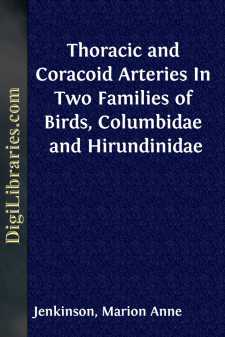Categories
- Antiques & Collectibles 13
- Architecture 36
- Art 48
- Bibles 22
- Biography & Autobiography 813
- Body, Mind & Spirit 142
- Business & Economics 28
- Children's Books 15
- Children's Fiction 12
- Computers 4
- Cooking 94
- Crafts & Hobbies 4
- Drama 346
- Education 46
- Family & Relationships 57
- Fiction 11829
- Games 19
- Gardening 17
- Health & Fitness 34
- History 1377
- House & Home 1
- Humor 147
- Juvenile Fiction 1873
- Juvenile Nonfiction 202
- Language Arts & Disciplines 88
- Law 16
- Literary Collections 686
- Literary Criticism 179
- Mathematics 13
- Medical 41
- Music 40
- Nature 179
- Non-Classifiable 1768
- Performing Arts 7
- Periodicals 1453
- Philosophy 64
- Photography 2
- Poetry 896
- Political Science 203
- Psychology 42
- Reference 154
- Religion 513
- Science 126
- Self-Help 84
- Social Science 81
- Sports & Recreation 34
- Study Aids 3
- Technology & Engineering 59
- Transportation 23
- Travel 463
- True Crime 29
Thoracic and Coracoid Arteries In Two Families of Birds, Columbidae and Hirundinidae
Description:
Excerpt
MYOLOGY AND ANGIOLOGY: HIRUNDINIDAE
Figs. 1, 2, 3, and 4 illustrate the following muscles and arteries described for Progne subis.
Myology
M. pectoralis thoracica, Fig. 1. The origin is from slightly less than the posterior half of the sternum, from the ventral half of the keel, almost the entire length of the posterolateral surface of the clavicle and adjacent portion of the sterno-coraco-clavicular membrane, and tendinously from the ventral thoracic ribs. This massive muscle covers the entire ventral surface of the thorax and converges to insert on the ventral side of the humerus on the pectoral surface.
M. supracoracoideus, Fig. 1. The origin is from the dorsal portion of the keel and medial portion of the sternum, and is bordered ventrally by the origin of M. pectoralis thoracica, and laterally by M. coracobrachialis posterior. The origin is also from the manubrium and the anterolateral portion of the proximal half of the coracoid and to a slight extent from the sterno-coraco-clavicular membrane adjacent to the manubrium. This large pinnate muscle converges, passes through the foramen triosseum, and inserts by a tendon on the external tuberosity of the humerus, immediately proximal to the insertion of M. pectoralis thoracica.
M. coracobrachialis posterior, Figs. 1 and 3. The origin is from the dorsolateral half of the coracoid, anterolateral portion of the sternum (where the area of origin is bordered medially by M. supracoracoideus, posteriorly by M. pectoralis thoracica, and laterally by M. sternocoracoideus), and also to a slight extent from the area of attachment of the thoracic ribs to the sternum. The muscle fibers converge along the lateral edge of the coracoid and insert on the median crest of the humerus immediately proximal to the pneumatic foramen. In passing from the origin on the sternum to the insertion on the humerus, the belly of the muscle bridges the angle formed by the costal process of the sternum and the coracoid.
M. sternocoracoideus, Figs. 2 and 3. The origin is from the entire external surface of the costal process of the sternum, and to a small extent from the extreme proximal ends of the thoracic ribs where they articulate with the costal process. The muscle inserts on a triangular area on the dorsomedial surface of the coracoid. Like M. coracobrachialis posterior, this muscle bridges the angle formed by the costal process and the coracoid.
M. subcoracoideus (ventral head), Figs. 2 and 3. The origin is from the dorsomedial edge of the coracoid at its extreme proximal end, and to a slight extent from the adjacent portion of the manubrium. The origin is medial to the insertion of M. sternocoracoideus. The ventral head passes anterodorsally along the medial edge of the coracoid and joins the dorsal head (not here described). The combined muscle then inserts by a tendon onto the internal tuberosity of the humerus.
M. costi-sternalis, Figs. 1, 2, and 3. The origin is from the anterior edge of the sternal portion of the first four thoracic ribs. This triangular muscle narrows and inserts on the posterior edge of the apex of the costal process....


